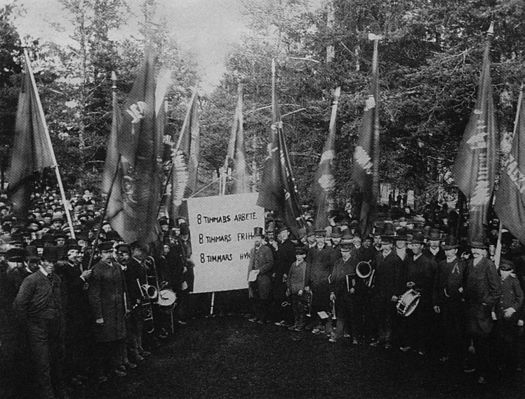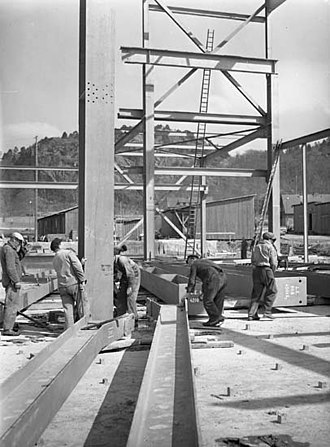

The labour movement in Sweden dates back to at least the 1850s, when Swedish workers initiated the organizing of previously spontaneous food riots into strikes, hence acting as an autonomous group. [1]


The labour movement in Sweden dates back to at least the 1850s, when Swedish workers initiated the organizing of previously spontaneous food riots into strikes, hence acting as an autonomous group. [1]
Modern types of labour unions emerged in the 1870s. An event that is usually considered to be central in the early days of the Swedish labour movement is the lecture "Hvad vil Social-Demokraterna?" ("What do the Social Democrats want?") by August Palm, at Hotel Stockholm in Malmö 6 November 1881. Five years later, in 1886, Sweden's first national labour union, Svenska Typografförbundet, was founded. [2] Another union of that sort, Svenska Postmannaförbundet, was founded later that same year. [3]
The labour movement soon divided into two parts, a political one and an union-specialized one. The union movement was organized in one central organization, the Swedish Trade Union Confederation (LO), founded in 1898, with the aim to organize all national labour unions in one central organization. Parallel to, but closely associated with this movement is the Swedish Social Democratic Party (SAP), founded in 1889. [4]
These two organizations has ever since dominated not only the Swedish labour movement but also the political life in general. One example of their close association is the fact that all members of LO was initially automatically made members of SAP. [5]
Even though LO has dominated labour relations in Sweden, the two other big confederations for unions, the Swedish Confederation of Professional Employees, TCO, and the Swedish Confederation of Professional Associations, SACO, are today almost as important participants as LO in the debate of labour economics. In 2008 for the first time the total number of active wage and salary members (i.e. excluding pensioner, students and self-employed) in TCO and SACO together surpassed that of LO. [6] In the year before that (2007), the center-right government considerably raised the fees to unemployment funds, which in particular hit funds run by LO unions. The result was large membership losses of LO funds and LO unions and rapidly declining union density. [7] The declining number of LO members is also related to the decreasing share of blue-collar workers in the labour force.

The Confederation of Professional Employees is a national trade union centre, the umbrella organisation for 13 trade unions in Sweden that organise professional and other qualified employees in both the private and the public sectors. The affiliated trade unions represent about 1.1 million employees. In 2018, the TCO affiliated unions made up 37% of all active trade union members in Sweden, making the confederation the second largest of Sweden's three major confederations. The largest TCO affiliate is Unionen with 551,000 active members in 2018. TCO is independent and not affiliated to any political party in Sweden. TCO is an affiliate of the European Trade Union Confederation and Eurocadres.

The Swedish Confederation of Professional Associations is a confederation of 26 independent professional associations in Sweden. It gathers some 556,000 members, all of whom are academics or graduate professionals with a university or college degree. The members include economists, lawyers, architects, graduate engineers, doctors, scientists, teachers and many others. A growing share of Swedish union members are affiliated to a Saco union: 1% in 1950 and 18% in 2018.

The Swedish Trade Union Confederation, commonly referred to as LO, is a national trade union centre, an umbrella organisation for fourteen Swedish trade unions that organise mainly "blue-collar" workers. The Confederation, which gathers in total about 1.5 million employees out of Sweden's 10 million people population, was founded in 1898 by blue-collar unions on the initiative of the 1897 Scandinavian Labour Congress and the Swedish Social Democratic Party, which almost exclusively was made up by trade unions. In 2019 union density of Swedish blue-collar workers was 60%, a decline by seventeen percentage points since 2006. A strongly contributing factor was the considerably raised fees to union unemployment funds in January 2007 made by the new centre-right government.

The Swedish Transport Worker's Union is a trade union representing workers in the transport industry in Sweden.
The Building Maintenance Workers' Union is a trade union in Sweden.

The Swedish Electricians' Union is a trade union representing electricians in Sweden.

The Swedish Union for Service and Communications Employees is a trade union in Sweden.
The European Trade Union Confederation was set up in 1973 to promote the interests of working people at the European level and to represent them in the European Union institutions. It is recognized by the European Union, the Council of Europe, and the European Free Trade Association as the only representative cross-sectoral trade union organization at the European level.

The economy of Sweden is a developed export-oriented economy aided by timber, hydropower, and iron ore. These constitute the resource base of an economy oriented toward foreign trade. The main industries include motor vehicles, telecommunications, pharmaceuticals, industrial machines, precision equipment, chemical goods, home goods and appliances, forestry, iron, and steel. Traditionally a modern agricultural economy that employed over half the domestic workforce, today Sweden further develops engineering, mine, steel, and pulp industries that are competitive internationally, as evidenced by companies like Ericsson, ASEA/ABB, SKF, Alfa Laval, AGA, and Dyno Nobel.
Unionen is a Swedish white-collar trade union.

The Saltsjöbaden Agreement is a Swedish labour market treaty signed between the Swedish Trade Union Confederation and the Swedish Employers Association on 20 December 1938, that became a model for other agreements. The rules on industrial action have come to be regarded almost as general legal principles of conflicts between the labor market forces. The agreement cemented the Swedish social norm that the two sides shall conclude agreements without interference by government. The agreement is still in effect, with the latest changes being made in 1976.
Farm Workers Union of Central Sweden was a trade union for agricultural workers in Sweden. The organization was active between 1906 and 1908. Carl Albert Svedberg was the chairman of the Farm Workers Union of Central Sweden. As of September 1907 the union had around one hundred local sections. The membership of the Farm Workers Union of Central Sweden was to a large extent concentrated to certain large agricultural estates. The key areas of activities of the union were located around Mälaren. The organization also established its presence in Västergötland, Östergötland, Dalarna and Gästrikland.
The Swedish Saw Mill Industry Workers Union was a trade union of saw mill workers in Sweden. The union was founded in 1891, it was initially known as Svenska sågverks- och brädgårdsarbetareförbundet.
The Swedish Cooperage Union was a trade union for coopers in Sweden.
The Swedish Workers Union was a labour organization in Sweden active between 1899 and 1919. Josef P. Nilsson was one of the key leaders of the organization. SvA sought to compete with the Swedish Trade Union Confederation (LO) for dominance of the Swedish labour movement, but remained a largely marginal feature. Being sponsored by corporate interests, SvA was commonly denounced as a yellow union. Following the 1909 general strike SvA faded away.
The union density or union membership rate conveys the number of trade union members who are employees as a percentage of the total number of employees in a given industry or country. This is normally lower than collective agreement coverage rate, which refers to all people whose terms of work are collectively negotiated. Trade unions bargain with employers to improve pay, conditions, and decision-making in workplaces; higher rates of union density within an industry or country will generally indicate higher levels of trade union bargaining power, lower rates of density will indicate less bargaining power.
The Swedish Typographers' Union was a trade union representing book printers in Sweden.
The Swedish Shoe and Leather Workers' Union was a trade union representing workers in the leather industry in Sweden.
The Swedish Hat and Fur Workers' Union was a trade union representing hat makers and furriers in Sweden.
The Swedish Bakery and Confectionery Workers' Union was a trade union representing workers in the food processing industry in Sweden.